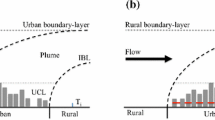Abstract
Horizontal and vertical sampling of the atmosphere has provided new information on the form of Montreal's urban heat island. The horizontal pattern under clear skies with light winds shows a major heat island, with marked gradients at the periphery, and a multicellular inner core. Retarded urban cooling rates in the evening yield a maximum heat-island intensity around midnight. Combined horizontal and vertical temperature surveys show that under conditions of strong rural stability, the lowest layers of the urban atmosphere become progressively modified as air moves toward the centre of the city. The change in the form of the potential temperature profile is in good agreement with Summers' internal boundary-layer hypothesis. In Montreal differing heights of heat and SO2 emission appear to produce more than one internal layer. SO2 observations, and heat input calculations reveal two major emission sources in Montreal; one associated with an industrial complex, and the other with the downtown core.
Similar content being viewed by others
References
Bornstein, R. D.: 1968, ‘Observations of the Urban Heat Island Effect in New York City’, J. Appl. Meteorol. 7, 575–582.
Chandler, T. J.: 1965, The Climate of London, Hutchinson, 292 pp.
Clarke, J. F.: 1969, ‘Nocturnal Urban Boundary Layer over Cincinnati Ohio’, Monthly Weather Rev. 97, 582–589.
Daniels, P. A.: 1965, ‘The Urban Heat Island and Air Pollution, with Applications to Edmonton’, M.Sc. Thesis, Univ. of Alberta.
Davidson, B.: 1967, ‘A Summary of the New York Urban Air Pollution Dynamics Research Program’, J. Air Pollution Control Assoc. 17, 154–158.
Davis, F. K. and Newstein, H.: 1968, ‘The Meteorology and Vertical Distribution of Pollutants in Air Pollution Episodes in Philadelphia’, Atmos. Environ. 2, 559–574.
DeMarrais, G. A.: 1961, ‘Vertical Temperature Differences Observed over an Urban Area’, Bull. Am. Meteorol. Soc. 8, 548–554.
Duckworth, F. S. and Sandberg, J. S.: 1954, ‘The Effect of Cities upon Horizontal and Vertical Temperature Gradients’, Bull. Am. Meteorol. Soc. 35, 198–207.
Georgii, H. W., Jost, D., and Shaeffer, H. J. : 1968, ‘Über die räumliche und zeitliche Verteilung von Schwefeldioxid und Sulfataerosolen in der unteren Troposhäre’, Scientific Report, Institute of Meteorology and Geophysics, Univ. of Frankfurt/Main, 55 pp.
Leahey, D. M.: 1969, ‘An Urban Heat Island Model’, Final Report, Geophys. Sci. Lab TR-69-11, School of Engineering and Science, New York Univ., 70 pp.
Ludwig, F. L. : 1970, ‘Urban Temperature Fields’, WMO Tech. Note No. 108, WMO No. 254 TP. 141, 80–107.
Munn, R. E., Hirt, M. S., and Findlay, B. F.: 1969, ‘A Climatological Study of the Urban Temperature Anomaly in the Lakeshore Environment at Toronto’, J. Appl. Meteorol. 8, 411–422.
Oke, T. R.: 1969, ‘Towards a More Rational Understanding of the Urban Heat Island’, Climat. Bull. 5, 1–20 (McGill University).
Oke, T. R. and Hannell, F. G.: 1970, ‘The form of the Urban Heat Island in Hamilton, Canada’, WMO Tech. Note No. 108, WMO No. 254 TP. 141, 113–126.
Powe, N. N. : 1969, ‘The Climate of Montreal’, Clim. Studies No. 15, Canada Department of Transport, Meteor. Branch, 51 pp.
Summers, P. W.: 1964, An Urban Ventilation Model Applied to Montreal, Ph.D. Thesis, McGill Univ., Montreal.
Yap, D., Gunn, K. L. S., and East, C.: 1969, ‘Vertical Temperature Distribution over Montreal’, Naturaliste Can. 96, 561–580.
Author information
Authors and Affiliations
Rights and permissions
About this article
Cite this article
Oke, T.R., East, C. The urban boundary layer in Montreal. Boundary-Layer Meteorol 1, 411–437 (1971). https://doi.org/10.1007/BF00184781
Received:
Issue Date:
DOI: https://doi.org/10.1007/BF00184781




